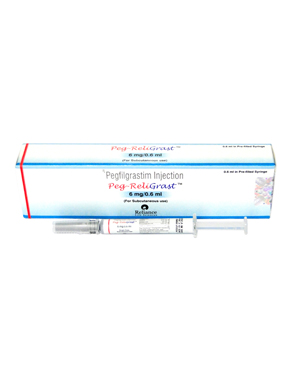Peg-ReliGrast®, Medical Products | Reliance Life Sciences - LifeSciences
- AbcixiRel® (Abciximab)
- AdaliRel® (Adalimumab)
- BevaciRel® (Bevacizumab)
- ChorioRel® (r-hCG)
- DarbeRel® (Darbepoetin)
- EtanerRel® (Etanercept)
- FostiRel® (FSH)
- InflixiRel® (Infliximab)
- MIRel® (Reteplase)
- OmaliRel™ (Omalizumab)
- Peg-ReliGrast® (Peg-GCSF)
- RanizuRel™ (Ranibizumab)
- ReliBeta® (Interferon beta-1a)
- ReliFeron® (Interferon α)
- ReliGrast® (GCSF)
- ReliPoietin® (Erythropoietin)
- RituxiRel® (Rituximab)
- SomatoRel® (r-hGH)
- TenecteRel® (Tenecteplase)
- TrastuRel® (Trastuzumab)
- DenosuRel™ (Denosumab)
- DenOsteoRel™ (Denosumab)
- GolimuRel® (Golimumab)
- UstekiRel® (Ustekinumab)
Business-Biosimilars-Peg-ReliGrast
Pegfilgrastim is used to reduce the chance of infection in people who have certain types of cancer and are receiving chemotherapy medications that may decrease the number of neutrophils (a type of blood cell needed to fight infection). Pegfilgrastim is also used to increase the chance of survival in people who have been exposed to harmful amounts of radiation, which can cause severe and life-threatening damage to bone marrow. Pegfilgrastim is in a class of medications called colony stimulating factors. It works by helping the body make more neutrophils.
Long-acting G-CSFs (Pegfilgrastim) have been modified to increase molecular size and thus evade clearance by the kidneys. Instead of renal clearance, long-acting G-CSFs are cleared from the body predominantly by circulating neutrophils. As a result, serum levels of long-acting G-CSFs remain high during neutropenia but decrease as neutrophil levels return to normal.
Pegfilgrastim is produced by covalently binding a 20-kd polyethylene glycol (PEG) molecule to the N terminus of filgrastim. Pegfilgrastim stimulates the production and maturation of neutrophil precursors and enhances the functions of mature neutrophils in the same manner as filgrastim.
In most studies, patients treated with pegfilgrastim had a lower risk of Febrile Neutropenia (FN) than those who received short-acting G-CSFs. Pegfilgrastim has pharmacological advantages over daily G-CSFs that makes it easily administrable, thus reducing the chance of incorrect delivery. For patients at higher risk of failure with daily G-CSF prophylaxis (e.g. risk of noncompliance, difficulties on performing regular hemograms, high risk of developing febrile neutropenia), pegfilgrastim might be the most appropriate option.

